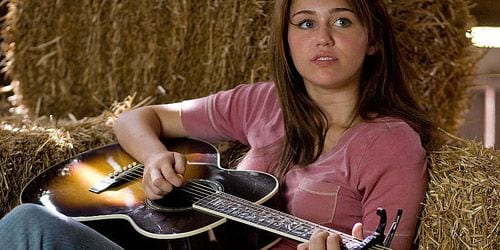
The Earth is calling out.
I wanna learn
What it’s all about.
— Miley Cyrus, “Wake Up America”
I waffled for a minute before taking my young daughters to Hannah Montana: The Movie. We’ve been watching less and less of the TV show as Hannah (Miley Cyrus) gets older and more boy-crazy, rebelling against her hillbilly father Robby Ray (Billy Ray Cyrus). Granted, at five and seven, my kids are probably a little younger than the movie’s target audience, but I wasn’t sure I had the energy to spin it as a lesson on how not to act. Turns out, the film saved me the trouble, letting Hannah get her fill of herself, then taking her to task for all her bratty self-centeredness.
For a minute. This being a Disney flick, such harsh reality is fleeting, quickly replaced with happy dreams come true.
Both the TV show and the movie are premised on high-schooler Miley Stewart’s efforts to keep her alter ego, pop star Hannah Montana, secret so that she can live a “normal” kid’s life. This supposedly prevents the trappings of fame from interfering with her friendships and her self-understanding (thus the recurring theme, “Best of Both Worlds”). But as the film begins, Miley is weary of the charade and starting to understand herself as a brand. With her PR rep Vita (Vanessa Williams) acting as a virtual fairy godmother, Miley chafes more than usual under Robby Ray’s authority. To encourage her to “find herself,” he brings her back to their hometown of Crowley Corners, Tennessee for a little “Hannah detox.”
Getting back to her roots, re-learning the importance of family, and purging herself of the poisons of materialism, Hannah’s process might mirror that of her audience. The Hannah persona is very nearly a villain here (but not quite, as that role is reserved for the Peter Gunn’s cartoonish tabloid reporter). Hannah’s usual pop songs are replaced with Miley’s country crossover tunes and most of the other regular cast members from the show (most notably Jason Earles and Mitchell Musso) are relegated here to cameo status. Since 2007’s album Hannah Montana 2: Meet Miley Cyrus, Disney has successfully marketed Miley Cyrus’ music separately from Hannah Montana’s. As rumors regularly surface that the Cyruses both want out of the HM franchise, one can’t help but wonder if this film isn’t a test run to see how audiences respond to Miley minus Hannah.
Predictably, the movie offers nothing like an existential crisis, and it’s a little heavy-handed with the country/city dichotomy, with slow motion shots of Miley horseback-riding through meadows as she gets back in touch with her “true” self. In one especially silly scene, she tries to balance both roles one more time, darting between a dinner with the Crowley Corners mayor (Beau Billingslea) as Hannah, and a date with her country-boy love interest (Lucas Till) as Miley, scrambling to change clothes and wigs in between. Inevitably, she slips up. Caught in a revolving door dressed as Hannah, but without the signature blonde wig, she faces both Travis and a six-year-old Hannah fangirl. Disillusionment is clear in both their faces, while Miley’s registers the recognition that she’s lost something in each of her identities.
While this lesson in self-discovery and societal expectations should be pretty profound, it loses some of its punch since there’s no question that both Miley and Hannah will ultimately be preserved. When Miley performs her epiphanic ballad “The Climb,” she notes her lessons learned, mainly that the destination isn’t as significant as the journey. But when she sings life is “Always gonna be an uphill battle. / Sometimes I’m gonna have to lose,” it seems disingenuous, given that she’s lost nothing but her sense of entitlement. Apparently that’s enough though, and so the fairy tale of having it all lives on.
